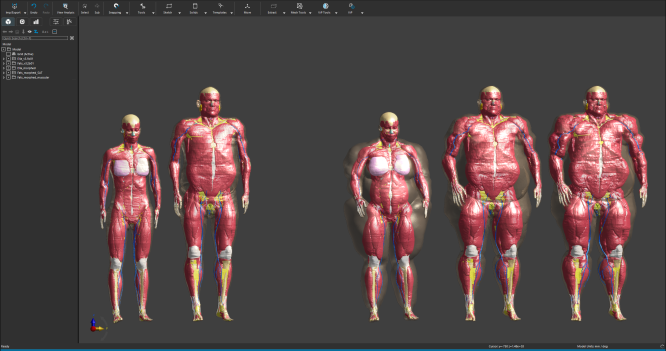Dec 13, 2022
Sim4Life Release V7.2
Sim4Life Release V7.2
Sim4Life V7.2 offers new features and major enhancements that strengthen the world’s leading in silico toolset for computational life science research, device design and optimization, and safety and electromagnetic compliance evaluations.
The highlights of Sim4Life V7.2 in a nutshell:
- Sim4Life Python Scripting: discover the power, flexibility, and comfort of Sim4Life’s integration with JupyterLab together with the upgrade to Python V3.8
- Exposures: efficient handling of pulsed exposures throughout Sim4Life, e.g., as modulated sources in thermal and neuro simulations
- Solver P-THERMAL: faster by more than 50×, thanks to graphical processing unit (GPU) acceleration
- Magnetic Resonance Imaging (MRI) safety:
- IMAnalytics Suite V1.2: new goal-oriented high-level application processing interface (API) for fast in silico evaluation and comparison with in vitro measurements
- new tools to convert multi-channel pTx coil array models into virtual observation points (VOPs) for real-time safety control
- functionality to generate potential implant routings for MRI safety evaluation
- Personalized modeling and artificial intelligence (AI): fully automatic generation of image-based head models for personalized simulations and the speed and ease of use of our new tool for electrode-placement in the 10-10 system on the head
- Ultra-obese Virtual Population (ViP) models: three morbidly obese versions of the adult models Ella and Fats added to the ViP library
- Dosimetry/compliance: compliant with the latest and forthcoming IEEE/IEC mmWave APD and SAR standards
Additional new release highlights include new computer aided design (CAD) modeling tools to get more out of our detailed anatomical models, new productivity features, general improvements as well as bug fixes, making your simulations more effective once again.
Feedback, as always, is warmly welcomed – we listen!
Sim4Life V7.2 in action: personalized modeling of transcranial electric and magnetic stimulation. Watch the movie here.
New Power and Flexibility for Sim4Life Python Scripting
- V7.2 now allows users to develop and execute their Sim4Life Python scripts from a live-linked JupyterLab window.
- Users thus benefit from powerful script documentation features and can rapidly build widget-based custom applications.
- This allows for process automation, workflow sharing, sophisticated postprocessing, large-scale parameter space explorations, and much more.
- Code auto-completion now comes with type hints, reducing user errors and accelerating scripts development.
- The API of Sim4Life V7.2 has been upgraded to Python 3.8, for enhanced compatibility with a wide range of third-party tools.
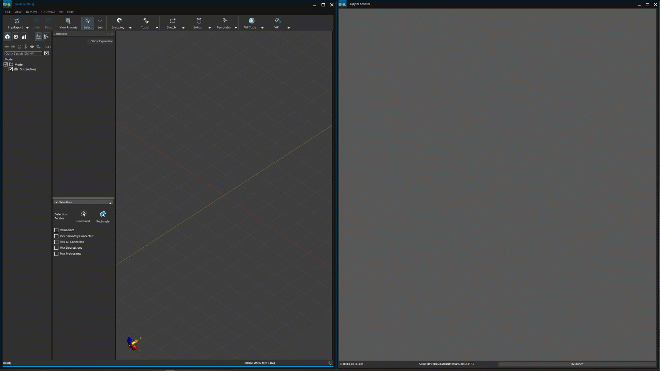
The new Jupyter Scripter window (live-link) in Sim4Life V7.2 provides a modern environment for running Python notebooks while remaining fully synchronized with the main application.
Pulsed/Modulated Exposure
Sim4Life V7.2 introduces pulsed/modulated exposures as first-class citizens in its computational ecosystem.
AMPLITUDE-MODULATED FIELDS
- Modulations are transient scaling time series that can be created from templates, analytically, and from computed or imported time series data.
- 3D fields, such as results of the low-frequency or Finite-difference time-domain (FDTD) solvers, can be amplitude-modulated with a simple postprocessing step.
- The new functionality allows to turn them into efficient 3+1D representations that are widely supported throughout Sim4Life, for example as exposure sources in neuronal dynamics or induced heating simulations.
- Of course, modulated exposures are natively and naturally handled throughout Sim4Life, e.g., when extracting dosimetric quantities (specific absorption rate (SAR), ICNIRP limits) or visualizing time-average (root mean square (RMS)) values.
- Modulation is a powerful concept to efficiently consider linear effects, e.g., to properly model non-ideal electrode interfaces, feeding circuits (e.g., in MR coils or phased array systems), or inductive neurostimulation.
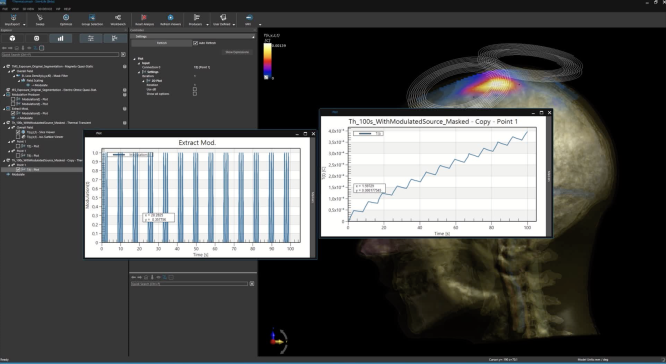 Thermal ripples resulting from pulsed exposure: use of amplitude-modulated field in Sim4Life V7.2 in low-frequency simulations for transcranial stimulation (transcranial electric and/or magnetic stimulation).
Thermal ripples resulting from pulsed exposure: use of amplitude-modulated field in Sim4Life V7.2 in low-frequency simulations for transcranial stimulation (transcranial electric and/or magnetic stimulation).
Thermal Simulations
In Sim4Life V7.2 the P-THERMAL module has received a significant performance and applicability boost by porting the kernel onto GPUs.
NEW GPU-ACCELERATED THERMAL SOLVER: >50x SPEEDUP
- With Sim4Life V7.2 it is now possible to run thermal simulations on modern GPUs, in both single and double precision. The new solver massively cuts down the simulation time, ultimately boosting development speed and cutting cost.
- The new GPU-empowered solver speeds up thermal simulations by more than 50 times (depending on GPU hardware) compared to central processing unit (CPU-)based modeling, which makes it ideal for iterative processes and design optimization.
- While currently running on a single-GPU, multi-GPU support will be added in the very near future to handle even larger simulations effectively!
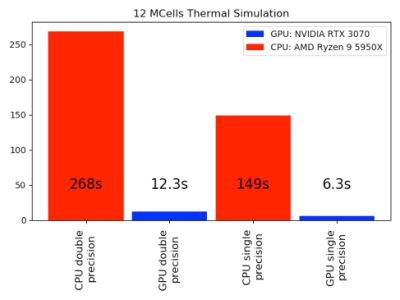
Thermal simulations in Sim4Life V7.2: significant simulation time speedup via GPU computing.
MRI Safety Assessment and MRI Design Toolsets
IMANALYTICS SUITE V1.2
Sim4Life V7.2 works smoothly with the updated IMAnalytics Suite V1.2 and facilitates the application of the FDA-qualified IMAnalytics and MRIxViP Medical Device Development Tool (MDDT).
- The Python application programming interface (API) now features an object-oriented high-level layer, while ensuring compatibility with older notebooks. It markedly increases confidence in results.
- Rewritten tutorial Python Notebooks can now easily be adapted to jump-start your customized applications. They introduce and demonstrate the powerful and flexible analysis tools for Tier2 and Tier3 evaluations.
- The graphical user interface (GUI) newly supports normalization to B1 limits, birdcage selection, and predefined excitations.
- MRIxLab has been extended by the MITS-TableTop (MITS-TT) fields library for Tier3 simulations using the Test Field Diversity (TFD) method, resulting in even greater accuracy and reproducibility.
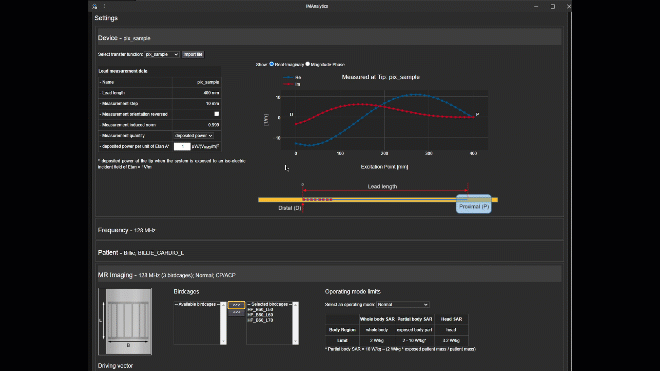
Predicting deposited power for a validation routing in the Test Field Diversity phantom with IMAnalytics Suite V1.2.
VIRTUAL OBSERVATION POINTS
Sim4Life V7.2 provides a new set of strongly requested design and safety tools for high-field MRI applications. These tools enable the computation, compression and export of Q-Matrix, VOPs, and SAR values from simulations of multi-port parallel transmit MRI coil, thus empowering online safety monitoring and helping coil manufacturers/users to meet regulatory requirements:
- A set of tools to compress simulation results of multi-channel parallel transmit coil arrays into a small set of VOPs
- Rapid SAR predictions with guaranteed conservativeness and tuneable, a priori known over-estimation for all possible shimming configurations
- Worst-case SAR identification
- Computation of Q-matrices and mass-averaged Q-matrices
- Export of Q-matrix and VOP data to MATLAB
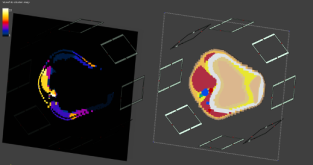
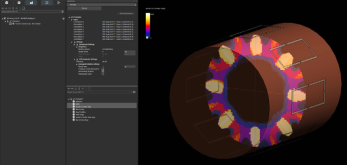 Visualization of the VOP cluster map associated with an 8-channel pTx coil array in a computational model of the human knee (left) and a homogeneous cylindrical phantom (right).
Visualization of the VOP cluster map associated with an 8-channel pTx coil array in a computational model of the human knee (left) and a homogeneous cylindrical phantom (right).
CONFIDENTIALITY-PROTECTING RADIOFREQUENCY TRANSMITTER MODELS (e.g., MRI COILS) FOR SAFE SHARING
Sim4Life V7.2 provides new functionality for Protected Models, which are self-contained Sim4Life models that can be shared with collaborators or customers without revealing confidential information.
- Essential content, such as CAD entities, material properties, and simulation settings are packed into shareable encrypted files.
- This allows creation of computational models of radiofrequency transmitters, such as MRI coils, that can be simulated in different contexts, e.g., loaded with an anatomical model, without exposing how the incident fields are generated.
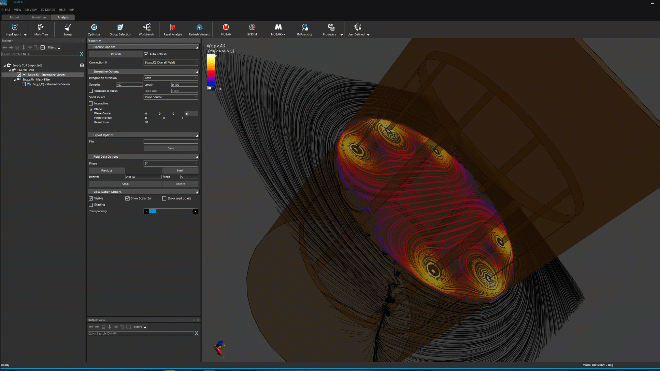
Exporting a 1.5T MRI coil as an encrypted model – without revealing the coil design – for subsequent sharing and use by third parties to study patient-specific SAR exposure.
Automatic Electrode Placement
Sim4Life V7.2 features a new tool to automatically identify 10-10 electrode system locations on the scalp and place custom electrode templates.
- Various applications (e.g., transcranial electric and/or magnetic stimulation (TES/TMS), temporal interference stimulation, electroencephalography) require accurate placement of electrodes at reference locations on the scalp. To support users, we have added a tool that models the 10-10 system on any head model, be it a personalized head model created with our new Automatic Head Segmentation tool or one of our predefined ViP models.
- Once the 10-10 System has been generated, suitably oriented electrode models can be automatically placed at the desired locations.
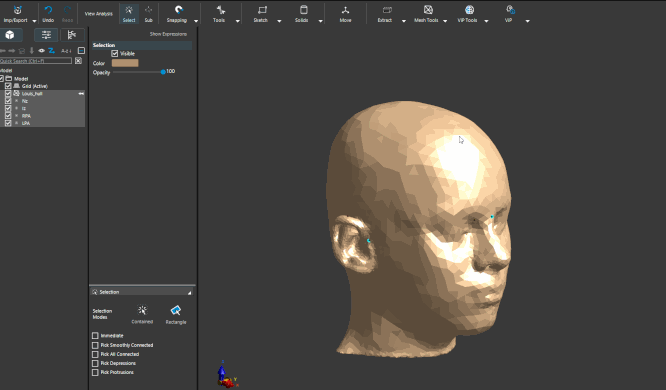
The new “10-10 System” tool in Sim4Life V7.2 generates the 10-10 system locations on a head model surface. Once the system has been established, the user can easily place custom electrode designs using the new “Electrode Placement” tool.
AI-Based Anatomical Model Generation
FULLY AUTOMATIC HEAD MODEL SEGMENTATION
Sim4Life V7.2 introduces the first one of our AI-powered applications – our Automatic Head Model Generation tool.
- The tool uses a mixture of AI and classical computer vision techniques to create detailed personalized head models from MR images.
- It allows to segment patient image data into 16 tissue classes (including brain structures, eyes, mucosa, internal air, and different skull and scalp layers) within minutes.
- Custom postprocessing steps are available to further improve segmentation quality, fill holes based on nearest-neighbor voting, and insert a dura layer between cerebrospinal fluid and skull.
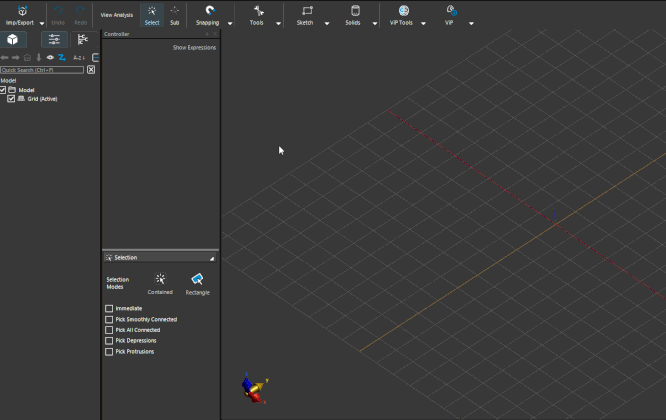
Generation of a whole head model in SIM4Life V7.2: the user can load a T1 MRI dataset (or both T1 and T2 data) and start the Auto-Label tool. After a few minutes, the MRI is segmented. The user can then easily extract a surface model and use it for simulations, or first edit the labelfield in iSEG.
Extended ViP Library
NEW ULTRA-OBESE MODELS
The ViP library has been extended to include three ultra-obese versions of the adult models Ella and Fats:
- The models were generated through a biomechanics-based morphing approach to ensure anatomically realistic internal organ placement, tissue distributions, and articulation geometries.
- They represent subjects with pathological body mass index (BMI) values >60 for enhanced population coverage, e.g., in in silico trial applications.
- Ella BMI63 and Fats BMI66 feature an increased amount of subcutaneous adipose tissue compared to the base models Ella and Fats. Fats BMI70 features an increased amount of both subcutaneous adipose tissue (SAT) and muscle.
- All three morphed models include the same number of tissue classes as the corresponding base models and are fully compatible with the continuously maintained IT'IS Material Properties Database.
- All three morphed models offer posing functionalities.
Ultra-obese ViP models in Sim4Life V7.2: from left to right the base models Ella and Fats and their morphed versions with BMI 63 (Ella), 66 (Fats, SAT-dominant version), and 70 (Fats, muscular version).
Dosimetry and Compliance Assessment
Such as exposure assessment standards for SAR and power density continuously evolve, Sim4Life ensures that its users are always up to date with the latest developments and ahead of forthcoming changes.
mmWAVE ABSORBED POWER DENSITY
- Evaluation of the absorbed power density (APD), as established in ICNIRP (2020) and IEEC95.1 (2019), is being standardized also in the context of FDTD simulations. The standard, IEC PAS 63446 ED1, is not yet finalized but the latest draft is implemented in Sim4Life’s power density evaluator.
- The entire frequency range (6 – 300 GHz) is comprehensively covered.
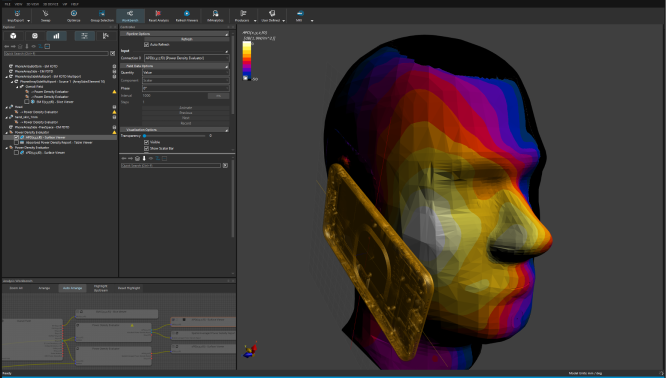 Sim4Life V7.2: Surface view of the absorbed power density generated by a 5G mobile phone at 28 GHz.
Sim4Life V7.2: Surface view of the absorbed power density generated by a 5G mobile phone at 28 GHz.
psSAR FOR HOMOGENEOUS PHANTOMS
- A preview of the new peak spatial SAR (psSAR) averaging algorithm for homogeneous phantoms according to the latest draft of the IEEE/IEC 62704-1 standard is available. The new algorithm postulates averaging cubes that are not aligned with the grid anymore, allowing for direct comparison with data from dosimetric measurement systems, such as DASY8.
- The original psSAR evaluator remains unchanged and should continue to be used in regulatory applications for now.
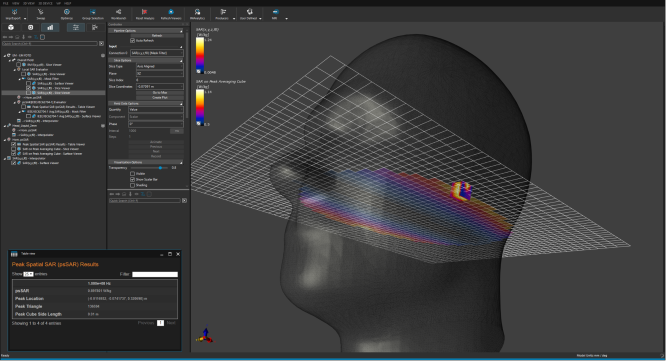 psSAR evaluation in the homogeneous SAM head phantom, according to the latest draft of IEEE/IEC 62704-1, now available in Sim4Life V7.2.
psSAR evaluation in the homogeneous SAM head phantom, according to the latest draft of IEEE/IEC 62704-1, now available in Sim4Life V7.2.
Productivity and Performance Tools
POWERFUL MODELING ENHANCEMENTS
- The routings toolbox now includes new tools to trim/extend routings.
- New tools permit extruding mesh patches, creating thin solid layers, detecting mirror symmetries, and creating symmetric models.
- A new snapping mode was added that allows to snap slice field viewers for aligned visualizations.
- Advanced entity sorting is now supported in the model tree.
- A new "Interpolate To" tool was added to interpolate image data onto the grid of another image dataset, e.g., to ensure co-localization of T1 and T2 data.
- New visualization modalities for labelfields exist in the modeler, including “Show Contours”.
- Support for various import/export of formats was added/extended (MMF voxel, iSEG tissue list, Slicer 3D colortable, Gmsh)
- The Python API continues to be extended (e.g., new functionality for image data and labelfields, numpy interfacing, parametric sweeping around axes, as well as API interfaces to the Mesh Doctor and Poser)
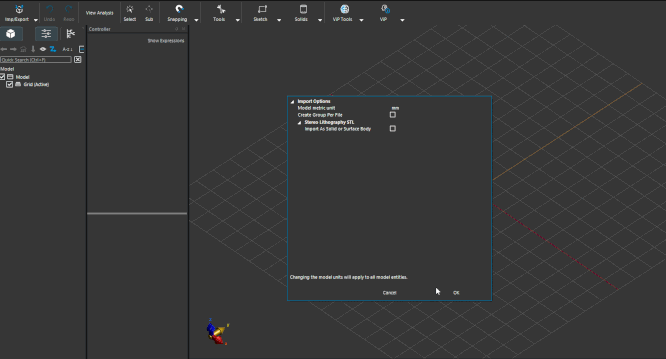
Symmetry modeling tool in Sim4Life V7.2 that allows to identify mirror symmetries and lets the user to cut and mirror the model across the symmetry plane.
DATA COMPRESSION
- Sim4Life V7.2 can now compress 3D field data in output files without affecting usage. This can be done in two different ways:
- In-place compression of existing simulation results
- On-the-fly compression of new simulation results (FDTD solver only).
- The compression level can be defined independently for each sensor.
- Lossless compression yields 2–5x disk space savings, without accuracy loss.
- Compression schemes with user-controlled precision are also available and permit storage space savings in the range of 8–20x at negligible accuracy cost (typically less than 0.1% for electric/magnetic fields).
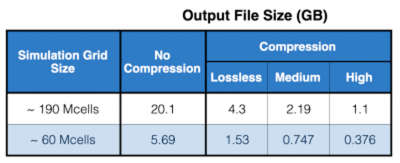
Field compression in Sim4Life V7.2: Two representative examples highlighting how the output file size is drastically reduced at different compression levels.
GUI ENHANCEMENTS
- Sim4Life V7.2 comes with a set of streamlined GUI elements to produce a more intuitive user experience and facilitate use:
- cleaned up Tabs, Ribbons
- intuitive Action Bar
- simplified UI elements
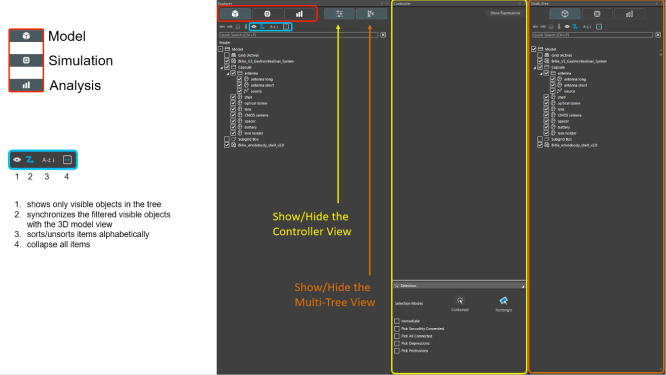
Streamlined and more intuitive GUI in Sim4Life V7.2.
A more comprehensive list of improvements, new features, and fixes is included in the Release Notes.
To experience the power and elegance of Sim4Life V7.2 or for further information, please email us at s4l-sales@zmt.swiss or call us at +41 44 245 9765.
The relevant Sim4Life installers for Win7/Win8/8.1and /Win10/11 64-bit platforms can be downloaded here. Existing customers with an up-to-date annual maintenance and support plan, will receive individually all pertinent information regarding the Software Installer Download and updated licenses.
IMPORTANT: For the CUDA-based solvers (CUDA P-EM-FDTD, P-THERMAL, P-ACOUSTICS), Sim4Life supports NVIDIA GPU models equipped with CUDA compute capability 3.5 up to 8.6, and requires device drivers that support the CUDA toolkit 11.0 and above. Note that NVIDIA may choose to discontinue certain drivers for specific operating systems, e.g., CUDA 11.0 drivers may not be available for Windows 8.1 for certain GPU series. In such a case, an update to Windows 10 or 11 may permit further usage of the GPU with Sim4Life.
At ZMT we are committed to support our customers with the most innovative software solutions, testing equipment, and service.
The Sim4Life Team



